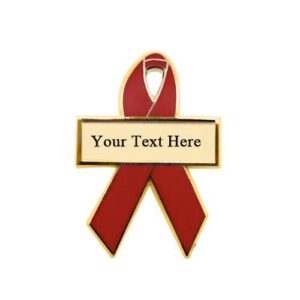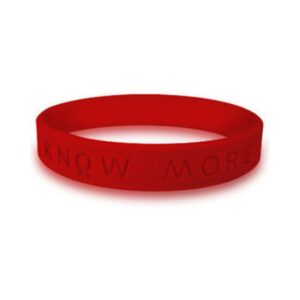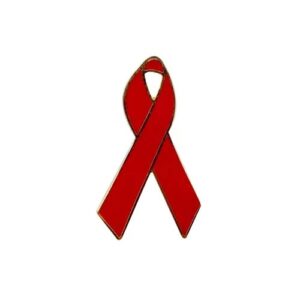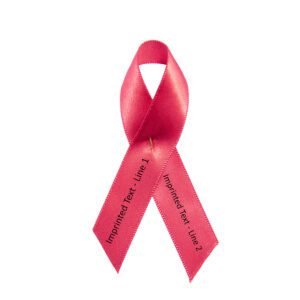Search by Color or Cause
$49.95
Wear your heart on your sleeve with a red fabric awareness ribbon on your lapel.
Shop Personalized Cause for awareness ribbons, pins, and wristbands for over 1000 causes.
Our red cloth fabric ribbons come in bags of 250 pieces (bulk).
Simple awareness ribbons started it all: a global movement for a better tomorrow. Today, an awareness ribbon is an iconic, worldwide symbol of hope for warriors and survivors, alike. For over twenty years, Personalized Cause has been at the forefront of the awareness ribbon movement, and strives to keep abreast of ever-changing awareness color and cause updates. Through this attention to cause awareness, Personalized Cause raises hope, encourages compassion, and highlights medical, social, mental health, autoimmune, and cancer causes. These causes are near and dear to many. Pin a ribbon to your lapel to show support for cancer research fundraisers or group marches for social change,
Personalized Cause has the most up-to-date and comprehensive awareness cause and color reference guide on the internet. Because of that, it has taken years to compile a list that is accurate and inclusive. You can find this extensive cause list under Awareness Ribbons Colors Causes and Meanings | Reference Guide. You can also use the Find Your Product search tool on the Home Page to find the product you’re looking for – search by color or cause.
Grosgrain ribbons primarily contain cotton, polyester and fiber blends. Satin ribbons, on the other hand, primarily contain nylon or polyester. Grosgrain ribbons also have thick horizontal fibers, whereas satin ribbons are smooth to the touch. Satin ribbons are much softer than grosgrain ribbons. Many people love satin ribbons for their beautiful shiny finish, allowing them to create a sleek look.
Double-faced satin ribbon is perhaps the most common type of satin ribbon available. Like the name suggests, this ribbon has two right sides. Therefore, it doesn’t matter what side faces upward or outward, as both of the sides look the same. The alternative is a single faced ribbon, which has a shiny outer side and a muted underside. Our satin ribbons are double-faced.
We offer these red fabric awareness ribbons in bags of 250 pieces. Our ribbons are perfect for fundraising, awareness events, cancer races, awareness campaigns, support groups, school fundraisers, funerals, memorial gifts, and promotional products. Wearing awareness ribbons sends a subtle message that you support a cause. For example, it might mean you are raising awareness for a particular social cause. Another reason to wear a ribbon is to support a medical or mental health cause. Further, perhaps the ribbon represents a cause that personally connects to a cause affecting animals. Again, the ribbon sits on the left side of the chest or over the heart which is symbolic for a cause that is heartfelt.
Please note: We cannot personalize these ribbons. However, click here to see our personalized fabric ribbons in similar colors with an attached safety pin on the back of the fabric ribbon.
Red Awareness Ribbons – Causes, Colors, Meanings and Months:
The primary causes associated with red awareness ribbons are Autoimmune Disorders, Bleeding, Clotting and Blood-Related Disorders, Cardiovascular Diseases, and Substance Abuse Prevention.
Autoimmune Disorders
Autoimmune disorders are a group of diseases that occur when the body’s immune system mistakenly attacks healthy cells, tissues, and organs. There are more than 80 known autoimmune diseases.
Autoimmune Disorder causes may include:
Adult Onset Still’s Disease
Epidermolysis Bullosa
Giant Cell Arteritis / Temporal Arteritis
Bleeding, Clotting and Blood-Related Disorders
Bleeding, clotting, and blood-related disorders are conditions that affect the blood’s ability to clot or the cells in the blood. These disorders can be inherited or acquired from other medical issues.
Bleeding, Clotting and Blood-Related Disorder causes may include:
Acquired Hemophilia
Antiphospholipid Antibody Syndrome (alternate color: Burgundy)
Bleeding Disorders
Blood Clotting Disorders
Blood Donors and Blood Donations
Churg Strauss Syndrome
Clotting Factor Deficiencies
Coagulation Disorders
Factor XI Deficiency (Hemophilia C)
Hemolytic Anemia
Hemophilia
Kawasaki Disease (alternate color: Orange and Red)
Myelodysplastic Syndromes
Platelet Disorders
Sickle Cell Anemia – (alternate color: Burgundy)
Vasculitis
Von Willebrand Disease
Cardiovascular Diseases
Cardiovascular diseases (CVDs) are a group of conditions that affect the heart and blood vessels. They include heart attack, stroke, heart failure, and other conditions.
Cardiovascular Disease causes may include:
Atrial Fibrillation (AFib)
Cardiomyopathy
Cardiovascular Disease
Congestive Heart Failure / CHF
Heart Disease
Heart Disorders
High Cholesterol Education
Hypertension / High Blood Pressure Education
Myocarditis
Pulmonary Embolism
Stroke
Supraventricular Tachycardia / SVT
Thrombotic Thrombocytopenic Purpura / TTP
Women’s Heart Health
Drug Abuse Prevention
Many organizations educate, advocate, and collaborate to prevent substance use.
Substance Abuse Prevention causes may include:
Alcohol Dependence Prevention
Impaired Driving Prevention
Mothers Against Drunk Driving / MADD
National Red Ribbon Week / DARE
Other Red Ribbon Causes Include:
Acquired Immune Deficiency Syndrome / AIDS
Blood Cancer
Burn Victims
Cavernous Angioma
Chronic Myeloproliferative Neoplasms including ET, MF, PV / MPN (alternate color: Orange and Red)
HIV
Marfan Syndrome
Poland Syndrome
Rosacea
Tuberculosis / TB
Awareness Months for Red Causes
Acquired Hemophilia Awareness Month – March
Adult Onset Still’s Disease Awareness Day – September 7
AIDS Awareness Month – December
Alcohol Dependence Awareness Month – April
Antiphospholipid Antibody Syndrome Awareness Month – June
Atrial Fibrillation (AFib) Awareness Month – September
Bleeding Disorders Awareness Month – March
Blood Cancer Awareness Month – September
Blood Clotting Disorders Awareness Month – March
Blood Donor and Blood Donations Awareness Month – January
Burn Victims Awareness Week – First full week in February
Cardiovascular Disease Awareness Month – February
Cavernous Angioma Awareness Month – June
Chronic Myeloproliferative Neoplasms including ET, MF, PV / MPN Awareness Month – September
Children’s Cardiomyopathy Awareness Month – September
Churg Strauss Syndrome Awareness Month – May
Clotting Factor Deficiencies Awareness Month – March
Coagulation Disorders Awareness Month – March
Congestive Heart Failure Awareness Month – May
Epidermolysis Bullosa Awareness Week – October 25-31
Factor XI Deficiency Awareness Month – March
Heart Disease Awareness Month – February
Heart Disorders Awareness Month – February
Hemophilia Awareness Month – March
High Cholesterol Education Awareness Month – September
HIV Awareness Month – December
Hypertension / High Blood Pressure Awareness Month – May
Impaired Driving Prevention Awareness Month – December
MADD / Mothers Against Drunk Driving Awareness Month – December
Marfan Syndrome Awareness Month – February
Myelodysplastic Syndromes Awareness Day – October 25
Myocarditis Awareness Month – April
National Red Ribbon Week / DARE Awareness Week – October 23 – 31
Platelet Disorders Awareness Month – September
Poland Syndrome Awareness Day – April 31
Pulmonary Embolism Awareness Month – March
Rosacea Awareness Month – April
Sickle Cell Anemia Awareness Month – September
Stroke Awareness Month – May
Thrombotic Thrombocytopenic Purpura / TTP Awareness Month – September
Vasculitis Awareness Month – May
Von Willebrand Disease Awareness Month – March
Women’s Heart Health Awareness Month – February
World AIDS Day – December 1
World Tuberculosis (TB) Day – March 24
WHAT IS THE HISTORY OF THE AWARENESS RIBBON?
In 1979, Penney Laingen’s husband was held prisoner during the Iran hostage crisis. To call attention to this, she placed yellow ribbons on trees in her neighborhood. She also created yellow ribbons for people to wear to show support for her husband and others being held hostage. This was the first time an awareness ribbon was used publicly as a way to silently voice support.
About ten years later, the group Visual AIDS used a bright red ribbon to represent awareness and support for AIDS and the lives lost to it. This trend caught on quickly. Awareness ribbons were so well accepted as a way to demonstrate support, in fact, that the New York Times declared 1992 as The Year of the Ribbon.
That was the same year the pink ribbon became associated with breast cancer. The Susan G. Komen Breast Cancer Foundation (now Susan G. Komen for the Cure) handed out pink hats to breast cancer survivors who participated in their Race for the Cure. Soon after, in 1992, Komen distributed pink ribbons to everyone who participated in the race.
The next big step came later that year. Alexandra Penney, editor of Self Magazine, produced their second annual Breast Cancer Awareness Month issue. This issue was inspired by Evelyn Lauder, Vice President of Estee Lauder. She was also a breast cancer survivor. Alexandra and Evelyn collaborated to create a pink ribbon to distribute in cosmetic stores throughout New York City. This action was so popular that eventually the pink ribbons were placed on cosmetics counters all across the United States during Breast Cancer Awareness Month.
That year, 1.5 million ribbons were distributed. On each one was a card that explained how to do self breast exams. They also collected over 200,000 petitions, asking the White House to provide additional funding for breast cancer research.
The next year, in 1993, popularity grew. Avon joined in the fight for breast cancer awareness and launched a pink rhinestone brooch in the shape of the pink awareness ribbon. In two years, sales from the pin raised over $10 million for breast cancer research. This visibility helped make everyone more aware of the need for research.
Many people believe that because of these awareness ribbons and the visibility they created, federal funding for breast cancer research increased from approximately $100 million in 1991 to over $550 million in 1996. This helped pave the way for pink ribbons and other colors, calling attention to the need for research money for causes such as autism, epilepsy, Alzheimer’s and many more.
Calling attention to various diseases and disorders, as well as social causes, is the impetuous behind awareness ribbons. Showing support and understanding can often make all the difference to those who struggle.




